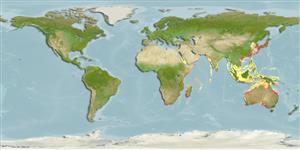Common names from other countries
Environment: milieu / climate zone / depth range / distribution range
экология
морской; солоноватоводный донно-пелагический; мигрирует в океане (Ref. 51243). Tropical; 40°N - 39°S, 18°E - 155°E
Indo-West Pacific: African southeast coast from Cape of Good Hope to southern Mozambique; northern Indian Ocean off Pakistan and northwest coast of India; northern Pacific from southern Korea and Japan, along the Chinese coast to Hong Kong; in Australia along the entire southern seaboard from North West Cape (north of Shark Bay) in Western Australia to the Burnett River (north of Brisbane) in Queensland.
Length at first maturity / Size / Вес / Возраст
Maturity: Lm 100.0 range ? - ? cm
Max length : 181 cm TL самец/пол неопределен; (Ref. 11025); наибольший вес (опубликованные данные): 75.0 kg (Ref. 11025)
колючие лучи спинного плавника (общее число) : 10 - 11; членистые (мягкие) лучи спинного плавника (общее число) : 25 - 30; колючие лучи анального плавника: 2; членистые (мягкие) лучи анального плавника: 7; позвонки: 25. In life, silvery grey becoming darker above and lighter below. Dorsal surface with a bluish bronze sheen that may become coppery on head. Preserved specimens vary in color according to treatment; usually grey but sometimes brown; darker above and lighter below (Ref 11025).
Adult fish found mainly near shore beyond the surf zone, occasionally going inshore. Juveniles exclusively found inshore. Juveniles recruit to estuaries at about 30 cm TL. An important food fish (Ref. 11025).
Griffiths, M.H. and P.C. Heemstra, 1995. A contribution to the taxonomy of the marine fish genus Argyrosomus (Perciformes: Sciaenidae), with descriptions of two new species from southern Africa. Ichthyol. Bull., J.L.B. Smith Inst. Ichthyol. No. 65, 40 p. (Ref. 11025)
Статус Красного Списка МСОП (Ref. 130435)
CITES (Ref. 128078)
Not Evaluated
Угроза для людей
Harmless
Использование человеком
рыболовство: коммерческий; аквакультура (рыбоводство): коммерческий; объект спортивного рыболовства: да
дополнительная информация
инструменты
Специальные отчеты
Скачать в формате XML
ресурсы в Интернет
Estimates based on models
Preferred temperature (Ref.
115969): 16.7 - 27.8, mean 25.3 (based on 600 cells).
Phylogenetic diversity index (Ref.
82804): PD
50 = 0.5020 [Uniqueness, from 0.5 = low to 2.0 = high].
Bayesian length-weight: a=0.00977 (0.00536 - 0.01781), b=3.07 (2.92 - 3.22), in cm Total Length, based on LWR estimates for this species & (Sub)family-body (Ref.
93245).
Trophic level (Ref.
69278): 4.5 ±0.6 se; based on diet studies.
устойчивость к внешним воздействиям (Ref.
120179): низкий, минимальное время удвоения популяции 4.5-14 лет (tm=6; tmax=40; K=0.03-0.24; Fec=900,000-1 million).
Prior r = 0.30, 95% CL = 0.20 - 0.45, Based on 1 full stock assessment.
Fishing Vulnerability (Ref.
59153): High to very high vulnerability (66 of 100).
